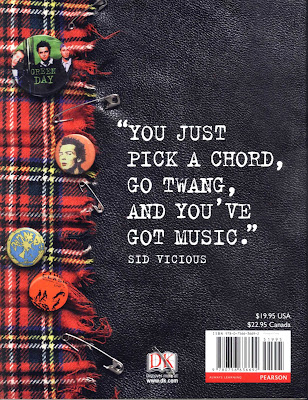‘Punk: The Whole Story’ (American edition) was published in trade paperback in 2006 by Dorling Kindersly. (The trade paperback version is considerably smaller in size that the hardcover version).
The book’s introduction indicates that its entries draw on archived material from the UK music magazines ‘MOJO’, ‘Q’, and ‘Sounds’, but it’s unclear to what extent or degree the entries in P:TWS adapt previously published stories.
The majority of the entries are four- to eight-page overviews of various punk groups or solo artists. Interspersed with these entries are smaller overviews of punk fashion, memorable venues, punk magazines and newsletters, punk art, and top singles and albums of the punk era.
There are numerous portfolios, mostly in black and white, taken in the heydey of the Punk Era, i.e.,. 1976 – 1979.
The book’s introduction indicates that its entries draw on archived material from the UK music magazines ‘MOJO’, ‘Q’, and ‘Sounds’, but it’s unclear to what extent or degree the entries in P:TWS adapt previously published stories.
The majority of the entries are four- to eight-page overviews of various punk groups or solo artists. Interspersed with these entries are smaller overviews of punk fashion, memorable venues, punk magazines and newsletters, punk art, and top singles and albums of the punk era.
There are numerous portfolios, mostly in black and white, taken in the heydey of the Punk Era, i.e.,. 1976 – 1979.
Somewhat inevitably in a volume such as this, the inclusion of some groups or singers as being ‘Punk’ will generate argument. For example, I personally consider Patty Smith to be the utlimate ‘punk poseur’, someone who fed on the aura and energy of the movement for the purposes of enhancing her own marginal talent, but she gets quite a bit of coverage in P:TWS.
As well, the inclusion of groups such as Generation X, The Stranglers, and Green Day stretches the boundaries of the definition of punk. The absence of any coverage of The Police, while more ephemeral groups such as The Buzzcocks and The Damned are given dedicated entries, indicates some snobbery on the part of the editors.
In the mid- to late- 70s I was aware of punk more as an interesting, if annoying sidelight to Rock Music proper. Indeed, that was the attitude of just about everyone under 25 in those days. Radio airplay was reserved for what is now labeled ‘classic rock’ : The Eagles, Elton John, Wings, Led Zeppelin, Lynyrd Skynrd, etc.
In 1976, The Ramones were regarded as a novelty act, on par with groups like Sha Na na, who re-did 50s songs as part of the nostalgia craze. The Sex Pistols were seen as gimmicky, relying on contrived ‘shock value’ to cover up their lack of musical talent. The full impact of punk on the US music scene really didn’t come until 1979, when record company execs began churning out albums from the emerging genre of ‘New Wave’.
But as a easy-to-read overview of the punk era at its peak, and the second-generation groups that sprang up in its wake, P:TWS does a good job.
Seeing photographs of the Ramones, Blondie, and The Clash circa 1976 will bring on some nostalgia in anyone who remembers those days when having a crewcut meant you were either a 'skinhead', a Marine, or someone with leukemia.....





































No comments:
Post a Comment